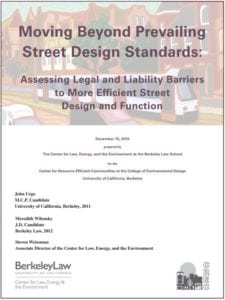Our city streets offer rich opportunities for reducing greenhouse gas emissions. Different allocations of space in street right-of-ways can encourage walking, bicycling and mass transit instead of car use. Street trees can reduce air temperatures and shade the sidewalk for pedestrians. Permeable pavements can increase filtration of rainwater into the ground, reducing loads and energy use in sewage treatment facilities. There are numerous other examples, ranging from programming streetlights to changing parking patterns.
The City Streets Project examines the design, function and regulation of a major city street with an eye toward reducing related greenhouse gas emissions. Working with experts in urban design, water use, traffic management, parking policy, human behavior and energy efficiency, we will select a typical street and identify wasteful design. We establish a vision for the design and use of that street would significantly reduce greenhouse gas emissions and work to make that vision a reality through education and policy development.
March 2012
Trees and Power Lines: Minimizing Conflicts between Electric Power Infrastructure and the Urban Forest
T rees and overhead power lines are not easy companions in the urban landscape. Cities and their inhabitants plant trees in order to provide safe and pleasant pedestrian environments, cool the urban landscape, improve storm water management, provide wildlife habitat, and mitigate climate change. At the same time, electric utilities spend billions annually on trimming and (often) removing those same trees to enhance reliability and public safety related to electric service. When trees and power lines share space too closely, the result can be power outages and fire. Conflicts between trees and power lines arise for a number of reasons, but most fundamentally trees continue to be planted under power lines that will grow into the wires overhead. Existing city tree ordinances address many issues, but rarely deal with interactions with power lines – and when they do, they only cover street trees.
rees and overhead power lines are not easy companions in the urban landscape. Cities and their inhabitants plant trees in order to provide safe and pleasant pedestrian environments, cool the urban landscape, improve storm water management, provide wildlife habitat, and mitigate climate change. At the same time, electric utilities spend billions annually on trimming and (often) removing those same trees to enhance reliability and public safety related to electric service. When trees and power lines share space too closely, the result can be power outages and fire. Conflicts between trees and power lines arise for a number of reasons, but most fundamentally trees continue to be planted under power lines that will grow into the wires overhead. Existing city tree ordinances address many issues, but rarely deal with interactions with power lines – and when they do, they only cover street trees.
December 2010
Moving Beyond Prevailing Street Design Standards: Assessing Legal and Liability Barriers to More Efficient Street Design and Function
 With Assembly Bill 32 and Executive Order S-3- 05, California has set ambitious goals to reduce greenhouse gas (GHG) emissions to 1990 levels by 2020 and 80 percent below 1990 levels by 2050. Meeting these targets will require drastic action in the transportation sector, which accounts for the largest share (37%) of the state’s GHG emissions. Two state laws, Senate Bill 375 and Assembly Bill 1358, aim to reduce vehicle travel and GHG emissions by requiring local and regional governments to design more energy and resource efficient communities. Though SB 375 and AB 1358 are important first steps in shifting travel to more efficient modes, they provide little guidance to local governments on how to create safe and comfortable street environments that encourage bicycling and walking. This research is the first step in a potential multi-year research project by CREC and CLEE that will provide guidance for state and local governments on developing and implementing codes and standards that encourage sustainable transportation.
With Assembly Bill 32 and Executive Order S-3- 05, California has set ambitious goals to reduce greenhouse gas (GHG) emissions to 1990 levels by 2020 and 80 percent below 1990 levels by 2050. Meeting these targets will require drastic action in the transportation sector, which accounts for the largest share (37%) of the state’s GHG emissions. Two state laws, Senate Bill 375 and Assembly Bill 1358, aim to reduce vehicle travel and GHG emissions by requiring local and regional governments to design more energy and resource efficient communities. Though SB 375 and AB 1358 are important first steps in shifting travel to more efficient modes, they provide little guidance to local governments on how to create safe and comfortable street environments that encourage bicycling and walking. This research is the first step in a potential multi-year research project by CREC and CLEE that will provide guidance for state and local governments on developing and implementing codes and standards that encourage sustainable transportation.
For more information on the City Streets Project, contact Steve Weissman at sweissman@berkeley.edu